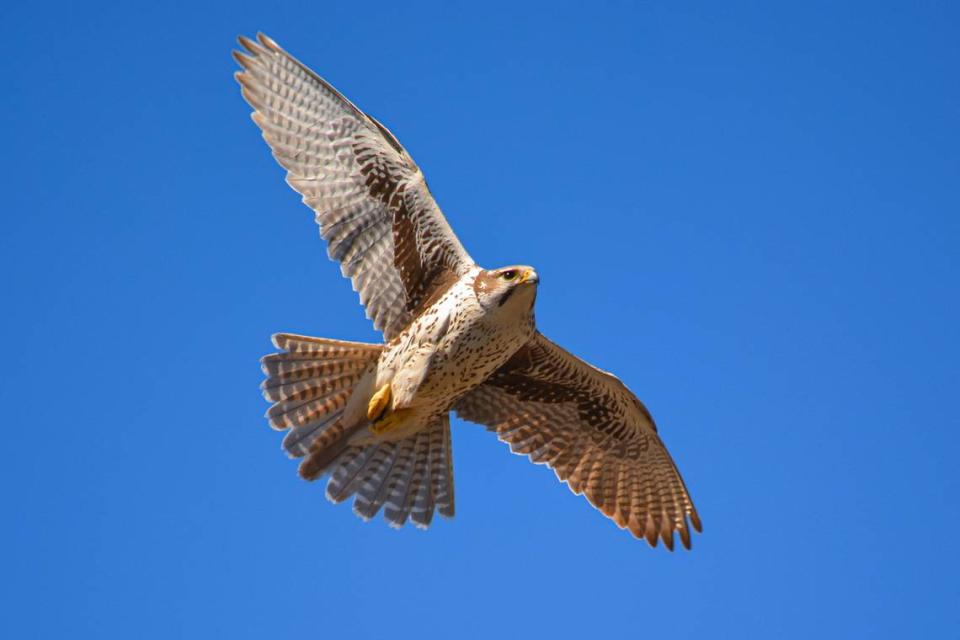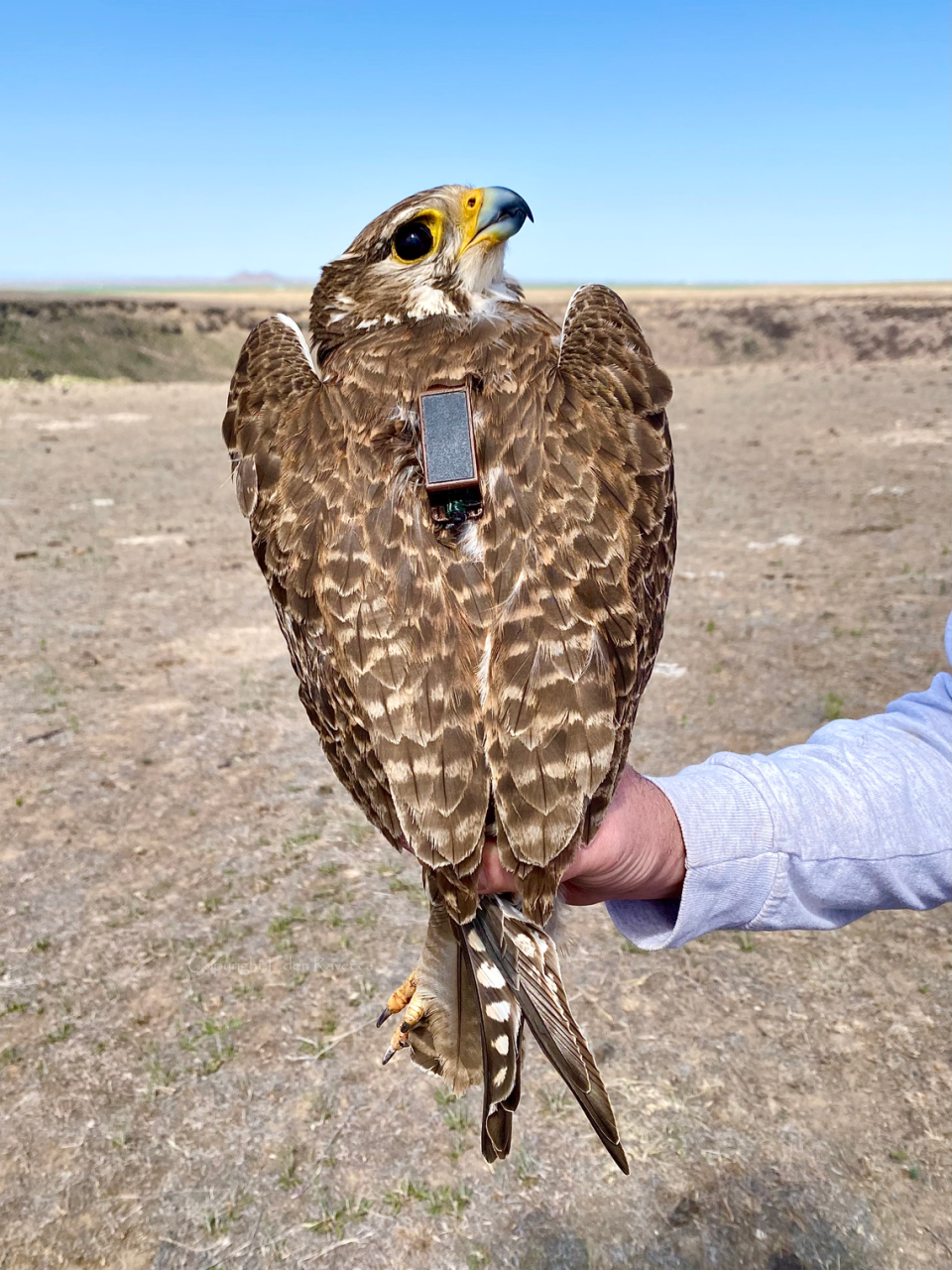These falcons fly with little backpacks. What do Boise State scientists hope to learn?
Bird watchers near the Snake River this summer may have spotted a small black pack amid the light brown plumage on raptors.
These aren’t unusually boxy feathers, but GPS transmitters. Boise State University scientists and their collaborators placed trackers on prairie falcons’ backs to find out where they fly and how they travel. The information they collect could help restore sagebrush and rehabilitate areas from burns and invasive species.
The presence of raptors tells scientists that all the animals the raptors eat, and everything those animals eat — all the way down the food chain — are healthy and balanced, said Eden Ravecca, a graduate student at Boise State University who worked on the project.
How researchers capture the birds
Here’s how the scene plays out:
A prairie falcon speeds home to a cliff near the Snake River. The bird doesn’t see a fine net in its path.
As the bird collides with the net, it collapses and wraps around the raptor. Ravecca said that’s when hidden scientists run up to the bird. One researcher uses their bare hands to grab its feet. Scientists untangle the falcon, then put a hood over its head.
“Of course, anytime you’re handling a bird, that’s going to be stressful for the bird,” Ravecca said. “They don’t know that we’re doing this really cool science, and that they’re ambassadors for their species. They’re just like, ‘Holy crap! A predator has caught me.’”
Ravecca estimated that scientists released the raptor with a solar-powered GPS transmitter in tow and a band around its leg less than an hour later. Researchers had already swabbed the bird’s talons and beak, weighed it and taken photos.
Prairie falcons are roughly the size of a football; female birds are larger than the male ones. They’re identified by their light-brown feathers with dark patches in their “armpits.”

The Morley Nelson Snake River Birds of Prey National Conservation Area has the highest density of breeding prairie falcons in the world. While prairie falcon populations are declining in other areas of the U.S., they’ve remained high over the past 30 years in this conservation area, said Jen Cruz, an ecology professor at Boise State also involved in the raptor-tracking project.
In this area, prairie falcons are essentially at the top of their food chain. They can eat rabbits, lizards, other birds and grasshoppers. But they mostly eat ground squirrels, especially during their nesting season.
The raptors’ nesting time historically coincides with the emergence of juvenile ground squirrels above ground. These young animals, which “haven’t got their smarts” and can’t yet avoid the predators, make easy prey, Cruz said.
When the falcons need to feed their young, the squirrels are a high-calorie food for the family — “like little cheeseburgers running all over,” Jeff McElwee, education programs assistant at the World Center for Birds of Prey, told the Idaho Statesman.
If it gets hot too early in the year, or if there’s a severe drought, ground squirrels might disappear underground for the season without giving prairie falcons a chance to bring them to their hatchlings. This, Cruz said, is “one of the iconic, really big consequences of climate change.”
When the food source an animal usually relies on during a particular season adapts to climate change before the animal has time to similarly adjust, the animal can starve.
Or the birds may just have to change their behavior. During a particularly hot week this summer, the tracked falcons flew farther than usual to get food. Ravecca said she thinks this was because the ground squirrels went underground in the extreme heat.
Raptors’ diet is sign of healthy ecosystem
Ground squirrels are sometimes found amid invasive grasses, such as cheatgrass, but they prefer sagebrush areas with other natural plants to eat.
Cheatgrass is “not tasty,” and it’s harder than areas with sagebrush for squirrels to navigate because of the dense vegetation, Cruz said. In the sagebrush, ground squirrels have shade and some protection from predators, she added.
When fires destroy areas with sagebrush, and cheatgrass overtakes the land, ground squirrels are less likely to remain and thrive. Without many squirrels, falcons and other predators also struggle to survive.
By tracking where the birds go to eat, researchers can discover the areas they prefer. If the raptors avoid locations where there were fires in the past 20 years, but happily forage in areas that have been recovering for 30 years, then researchers can figure out how long it takes for the habitat to be fully restored.
If raptors avoid roads, even those surrounded by sagebrush, conservationists will know to focus on restoring areas far from any traffic.
The presence of raptors “indicates that everything (ecologically) below them is doing well and is healthy and is balanced,” Ravecca said.
Scientists discover falcons’ commute times vary
The solar-powered GPS transmitters placed on 10 prairie falcons are smaller than a lighter. If the birds were human-sized, it would be as if they’re wearing a wallet-sized backpack with shoelace-sized straps, Ravecca said.

Three days a week, when the backpacks have sufficient battery power, the transmitter switches on once the raptor reaches a certain speed. It then reports the bird’s location every two seconds.
While they don’t yet know exactly why the falcons travel where they do, scientists now have data to help them figure it out.
Researchers will learn not only where prairie falcons hunt, but also how travel varies between individual birds and sexes.
Some stay close to home. One male traveled about 175 miles in one day to get food for the family — this raptor, Ravecca said, deserves the “dad of the year award.”

